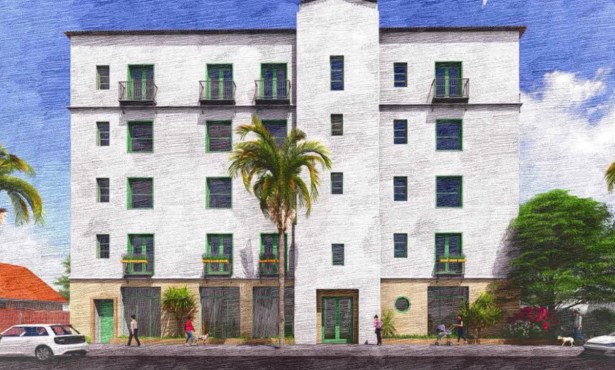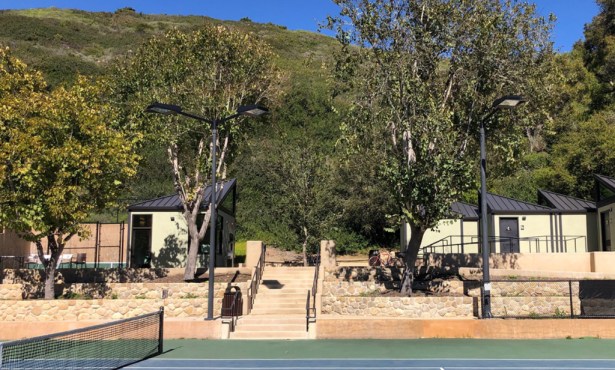Renewing an Old, Deep Groove
The Spanish Harlem Orchestra Serves Authentic Salsa, New
York-style
by Josef Woodard
 When the skilled veteran
When the skilled veteran
pianist/arranger Oscar Hernandez first assembled the Spanish Harlem
Orchestra in 2000, the underlying energy was partly nostalgic. He
wanted to recreate the powerful sound of real salsa, deep and
feisty stuff that has not been watered down for mass
consumption—the kind he used to play while growing up in New York
City.
Instead of being a novelty one-off, the band grew wings,
surprising many by taking the 2003 best salsa/merengue Grammy for
the album Across 110th Street, with Ruben Blades as a guest. While
the band’s recorded work is dressed to impress and get bodies
moving, hearing this intricate music live is the true test, and
Santa Barbara will get its chance at Campbell Hall next
Tuesday.
Despite the band’s name, Hernandez now lives in the San Fernando
Valley, 3,000 miles from Spanish Harlem. That’s where he was when I
spoke with him last week.
Did you have specific goals for the band early
on? I didn’t have any specific goals, but just like with
everything else now in my life, I feel that it was meant to be.
Aaron Levinson, who is mainly a deejay and music fan, got a deal to
do this as a concept record and he called me to produce it,
musically. That was the birth of the Spanish Harlem Orchestra. It
came at a perfect time. The essence of this music has been lost in
the last 10 to 15 years. Through the pop, bubblegum salsa, and
commercial salsa, so to speak, it kind of lost its way. We’re
playing the music the way we learned how to play it back in the
day, in the ’70s, during its heyday, through all the great people
who we played with. I think it has given me an incredible calling
in my life. And it’s a great group. (Laughs.) We’re taking no
prisoners, man.
The focus on the musicians goes back to the tradition of
Tito Puente and other pioneers, doesn’t it? No doubt about
it. The essence of this music is directly linked to the music of
the ’50s and ’60s—Tito Puente, Machito, Tito Rodríguez, Mongo
Santamaria, and later Eddie Palmieri and Ray Barretto. I could name
a bunch of other people, including Celia Cruz. But a lot of those
people are gone. That’s why what we’re doing takes on a new
importance, beyond the music itself. It’s maintaining the legacy of
what this music is and should be.
People may not understand the importance of New York
City in crystallizing this music that became salsa and Latin jazz.
Do you find that’s the case? Oh, yeah. New York was the
hotbed in those days, a who’s who as far as people making this
music happen, which went on to influence the rest of the world. The
whole Fania era was critical—they were like the Motown of Latin
music, so to speak. They had so many artists and so many people who
went on to influence others. And all of that came directly out of
New York. Spanish Harlem Orchestra is a microcosm of that sound of
New York, done 30 years later.
Despite the scarce radio play situation, salsa has a big
following on an underground level, wouldn’t you say? It
has always had a big following. Today, it has a huge following, but
now it’s more geared to dancing rather than the music. If you would
have told me 30 years ago that we could go to some remote city in
England and there would be 700 people there dancing salsa, I would
have said you’re crazy. But that’s exactly what’s happening.
You seem to be making a lot of new converts
lately. I think so. Sometimes, fans will drag their
friends in and when they go, they have a new respect and interest.
It’s a beautiful thing. They not only get turned on to us, but also
to the music, which is ultimately the important thing.
4·1·1 Spanish Harlem Orchestra plays UCSB’s
Campbell Hall on Tuesday, February 13 at 8 p.m. Tickets are $40
general and $19 for students. Call 893-3535 or visit www.artsandlectures.ucsb.edu
for tickets and more information.



